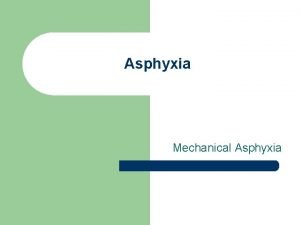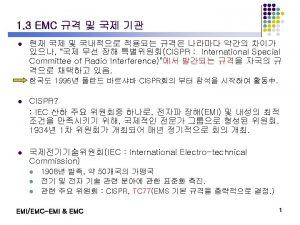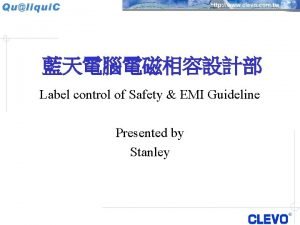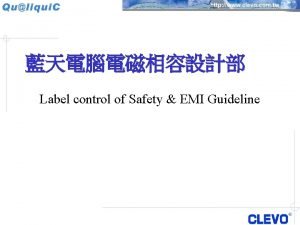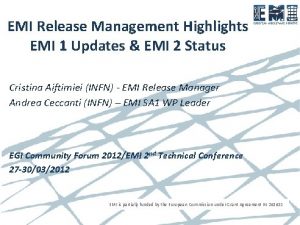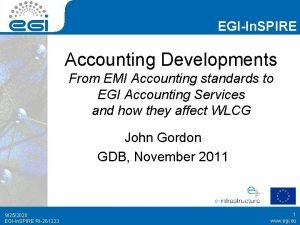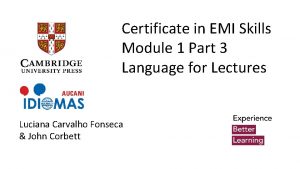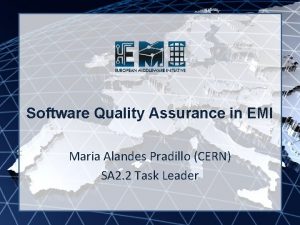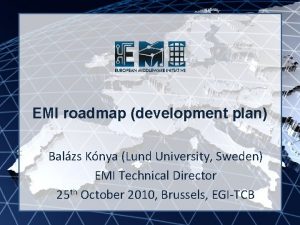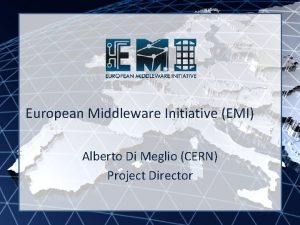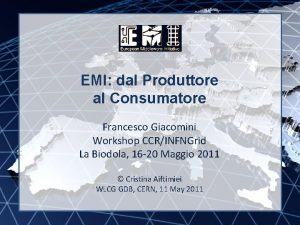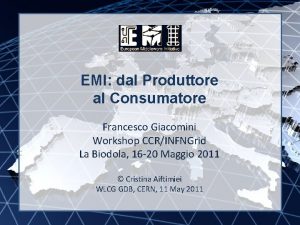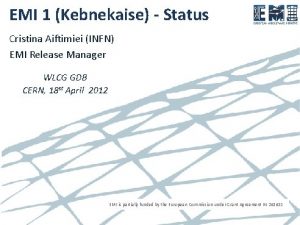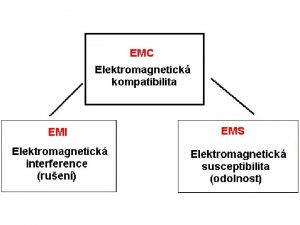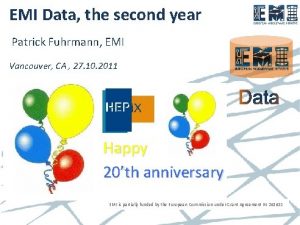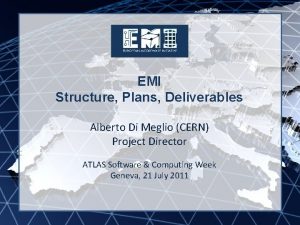EQUATED MONTHLY INSTALLMENTS EMI EQUATED MONTHLY INSTALLMENTS EMI


























- Slides: 26

EQUATED MONTHLY INSTALLMENTS (EMI)

EQUATED MONTHLY INSTALLMENTS (EMI) Today, we have a loan for just about everything, be it a house, car, foreign trip and even a mobile.

EQUATED MONTHLY INSTALLMENTS (EMI) § The 'loan culture' has caught on in a big way. A majority of people have availed of loans at some point or the other. § But do we really know how the EMI on the loan is calculated?

EQUATED MONTHLY INSTALLMENTS (EMI) Today’s lesson on EMI attempts to simplify this concept for you.

What is an EMI?

EQUATED MONTHLY INSTALLMENTS (EMI) § An Equated Monthly Installment (EMI) is the amount paid by a borrower each month to lender of the loan. § The EMI is an unequal combination of principal (the actual loan you have taken) and interest rate.

EQUATED MONTHLY INSTALLMENTS (EMI) § EMI payments are made every month, generally on a fixed date, for the entire tenure of the loan, till the outstanding amount has been completely repaid. § It is important to understand how banks work out the EMI so that you would find it easier to evaluate various loan options.

EQUATED MONTHLY INSTALLMENTS (EMI) So how does the bank arrive at the future value of a loan & interest to be repaid at future dates?

EQUATED MONTHLY INSTALLMENTS (EMI) The answer is ‘Time value of money’. The theory of time value of money says that a rupee receivable today is more valuable than a rupee receivable at a future date. This is because the rupee received today can be invested to earn interest. For instance: Rs. 100 receivable today can be invested at, say, 9% interest and therefore enables one to earn additional Rs. 9 in a year.

EQUATED MONTHLY INSTALLMENTS (EMI) In the earlier years of loan repayment, it is mainly the interest payments that are being made while the principal amount is much less. As the loan matures, and as the principal gradually gets paid, the outstanding loan amount reduces. The interest component thus becomes lower than the principal, and finally minimal.

EQUATED MONTHLY INSTALLMENTS (EMI) PAYMENT OPTIONS § FIXED RATE EMI: Fixed rate loans are those which remain same throughout the tenure. This can be best option only when interest rate have reached bottom, from where upward trend is expected. § FLOATING RATE EMI: Floating rates move in tandem with market and RBI measures which are prone to fluctuation depending on the market and economy.

Does my EMI stays constant?

CURRENT ACCOUNT DEFICIT EQUATED MONTHLY INSTALLMENTS (EMI) Let us see the formula of the Current Account Balance (CAB) CAB = X - M + NI + NCT X = Exports of goods and services M = Imports of goods and services NI = Net income abroad [Salaries paid or received, credit / debit of income from FII & FDI etc. ] NCT = Net current transfers [Workers' Remittances Yes. Though the EMI is an unequal (unilateral), Donations, Aids & combination of interest rate and Grants, Official, Assistance and Pensions etc] principal, it stays constant. Unless…

EQUATED MONTHLY INSTALLMENTS (EMI) Unless: § § § If you prepay part of the loan, the amount of your remaining EMIs will not remain the same if you leave the duration of your loan constant. In case you have taken a floating rate loan, the EMI will change as the interest rates change. Of course, some have the option of the EMI not changing but the tenure increasing or decreasing. You opt for a loan where the EMI keeps increasing over the years. To give an example, let's say you have a 10 year loan. The EMI stays constant for three years, then rises for the next three years and rises again for the last four years. This will help young individuals who cannot afford a huge EMI at this point but can do so as their earnings rise.

Now the Formulae

EQUATED MONTHLY INSTALLMENTS (EMI) The calculation of EMI depends on three major factors: § § § Interest Rate Loan Amount Tenure of the Loan

EQUATED MONTHLY INSTALLMENTS (EMI) Mathematically, EMIs are computed using the formula mentioned below: EMI = (LOAN AMOUNT x INTEREST) x (1+INTEREST)^N [(1 + Interest)^N] - 1

EQUATED MONTHLY INSTALLMENTS (EMI) Let’s consider an example here: § § § Loan amount = Rs. 10, 000/- Interest rate = (% rate) / 12 months = 11% / 12 months = 0. 0091 Loan period (N)= 15 years = 180 months

EQUATED MONTHLY INSTALLMENTS (EMI) EMI = (loan amount x interest) x (1+interest)^n [(1 + Interest)^n] - 1 EMI = (10, 000 x 0. 0091) x (1+0. 0091) ^180 [(1+ 0. 0091) ^180]-1 EMI – Rs. 11, 365. 96 which has to be paid every month towards principal and interest amount.

EQUATED MONTHLY INSTALLMENTS (EMI) METHOD OF COMPUTATION The various methods adopted are: § Annual reducing method: A method of calculating interest on the reduced principal at the end of every year. However as repayments for all loans are EMI, though the principal is reduced every month, the interest is calculated on the original loan amount for twelve months after which the repayments towards principal are taken into account. Basically, this method will benefit you the least.

EQUATED MONTHLY INSTALLMENTS (EMI) METHOD OF COMPUTATION § Monthly reducing loans: This is a better and easy to understand method of EMI calculation and is usually the most common calculation method adopted. In this calculation methodology there is a reduction in principal with EMI being paid every month. The interest is calculated on the outstanding balance. § Daily reducing loans: In this method the principal reduces every day, with daily loan repayments. The interest is charged on the outstanding balance. However, daily EMI payment is not a very feasible option.

EQUATED MONTHLY INSTALLMENTS (EMI) PRE-EMI AND ADVANCE DISBURSEMENTS (Relevant incase of home loan) There are instances where the borrower may opt for a partial disbursement of their home loan on the basis of the stages of construction of their house. In such cases, a pre-EMI is to be paid every month till the final loan is disbursed. The real loan repayment would commence only after the entire loan is disbursed. This pre-EMI would, therefore, comprise only the interest accrued on the disbursed money.

EQUATED MONTHLY INSTALLMENTS (EMI) Also, there are cases when the entire loan may be disbursed by lenders before the completion of house construction. This is known as an advance disbursement and is undertaken by the lender when it is requested by the borrower and the lender is convinced of the capabilities of the builder to complete the construction work in time. In these cases, the EMI payment starts immediately from the date of disbursement.

CURRENT ACCOUNT DEFICIT EQUATED MONTHLY INSTALLMENTS (EMI) Let us see the formula of the Current Account Balance (CAB) CAB = X - M + NI + NCT X = Exports of goods and services M = Imports of goods and services NI = Net income abroad [Salaries paid or received, credit / debit of income from FII & FDI etc. ] NCT = Net current transfers [Workers' Remittances (unilateral), Donations, Aids & Hope you have understood the Grants, Official, Assistance and concept of EMI and its working. Pensions etc]

Please give us your feedback at professor@tataamc. com

DISCLAIMER The views expressed in this lesson are for information purposes only and do not construe to be any investment, legal or taxation advice. The lesson is a conceptual representation and may not include several nuances that are associated and vital. The purpose of this lesson is to clarify the basics of the concept so that readers at large can relate and thereby take more interest in the product / concept. In a nutshell, Professor Simply Simple lessons should be seen from the perspective of it being a primer on financial concepts. The contents are topical in nature and held true at the time of creation of the lesson. This is not indicative of future market trends, nor is Tata Asset Management Ltd. attempting to predict the same. Reprinting any part of this material will be at your own risk. Tata Asset Management Ltd. will not be liable for the consequences of such action. Mutual Fund investments are subject to market risks, read all scheme related documents carefully.
 Equated installment
Equated installment Mechanical asphyxia definition
Mechanical asphyxia definition Emi emc 차이
Emi emc 차이 Nergie merci emi
Nergie merci emi Emi setyaningsih
Emi setyaningsih Www.emi.edu.bo
Www.emi.edu.bo Emi and safety
Emi and safety Luna park slides
Luna park slides Emi teaching strategies
Emi teaching strategies Emi tools
Emi tools Emi and safety
Emi and safety Francouz vzor
Francouz vzor Emi setyaningsih
Emi setyaningsih Emi
Emi Emi skills
Emi skills Emisja emi w pcb
Emisja emi w pcb Emi pronunciation
Emi pronunciation Emi setyaningsih
Emi setyaningsih Egi accounting
Egi accounting Emi certificate
Emi certificate Transporte de cali
Transporte de cali Eshak emi kasalligi
Eshak emi kasalligi Effective monthly interest rate
Effective monthly interest rate Hmis forms
Hmis forms Building safety programme: monthly data release
Building safety programme: monthly data release Housekeeping monthly the good wife's guide
Housekeeping monthly the good wife's guide Section 3-1 average monthly expenditures
Section 3-1 average monthly expenditures

